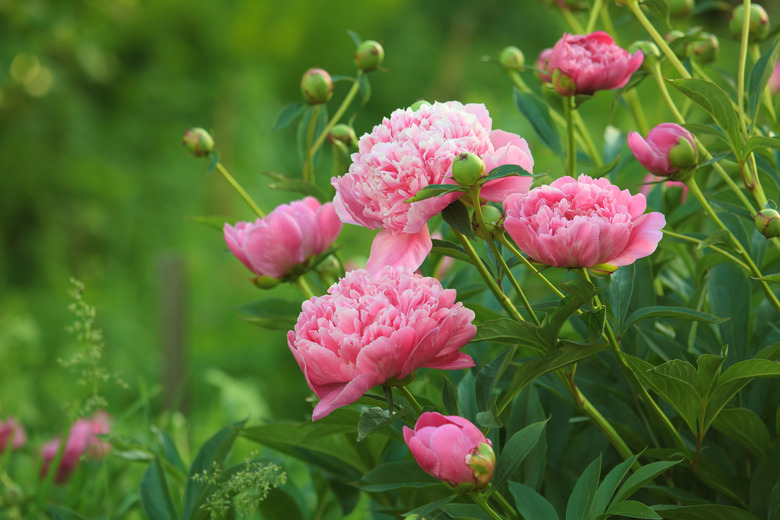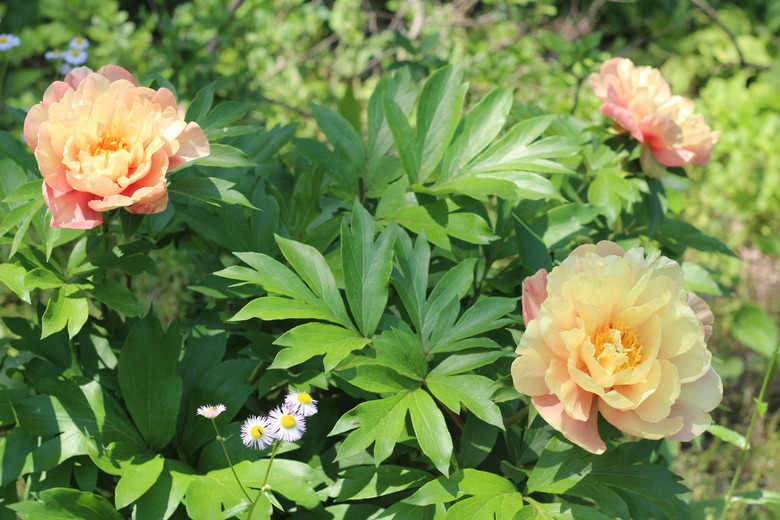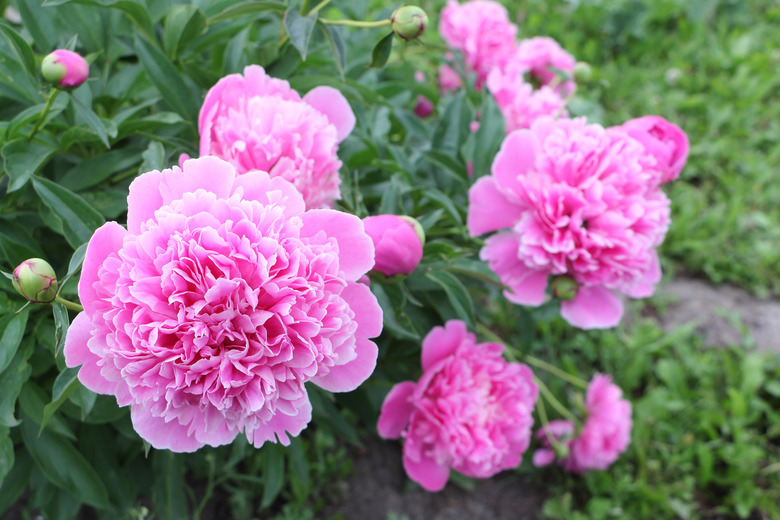How To Grow Peonies
We may receive a commission on purchases made from links.
How can these flowers be so overwhelmingly, extravagantly beautiful? With lush and lovely foliage and scrumptious flowers, peonies (Paeonia spp.) are one of the most beloved plants in the perennial garden. You can find species and cultivars with blossoms in white, pink, coral, red, maroon and yellow. Some flower buds change colors as they open. When planted well and given good cultural care, these plants may be around to delight your great-great-grandchildren.
Best Uses for Peonies
Best Uses for Peonies
If there were prizes given for the most beautiful perennial flowers, peonies would be a good bet to win. Peonies are superstar perennials, lasting not one year, not 10 years, but up to 100 years in your garden. Their foliage alone is exceptional; their clumps of glossy green leaves are a welcome addition to any walkway, hedge or border. The leaves turn shades of purple and gold in autumn.
The blossoms are truly, outrageously gorgeous. They are fat and fluffy, fully fragrant and incredibly lovely in the garden or cut in a vase. You'll find two primary types in commerce: herbaceous or bush peonies that have green shrubby stems between 1 and 3 feet tall and wide and tree peonies that have woody stems and can grow to 7 feet tall and 5 feet wide. Add to your choices the six different types of peony flowers: anemone, single, Japanese, semidouble, double and bomb. Each has its loyal fans, and all are exquisitely beautiful. Plant them in garden beds or in containers on the patio.
How to Grow Peonies
How to Grow Peonies
Starting Peonies From Tubers
Starting Peonies From Tubers
Herbaceous peonies are usually planted as root clumps and grow into green-stemmed flowers. Most gardeners grow them from bare root tubers with three to five eyes (buds).
- Dig a fairly large hole at least 24 inches in each direction
using a garden fork to loosen the sides of the hole as well. - Build up a mound of soil inside the planting hole
and position the peony tuber on top with its roots
hanging down the sides of the mound. The eyes should be between 1/2 inch and 2 inches below the soil surface depending on your climate. The colder the climate, the deeper they should be planted. These same instructions apply to intersectional peonies, which are hybrids of bush and tree varieties. - Remember that bush peony plants can grow to 3 feet tall, so space the tubers 3 to 4 feet apart to give them a little elbow room. Planting them too close creates stagnant air that can allow fungal diseases to develop.
- After the tubers are planted, backfill the hole and water thoroughly.
- Install a flower support while the plants are small since it will become virtually impossible once they are grown.
Planting Tree Peonies
Planting Tree Peonies
A tree peony has a woody stem that is attached to the root clump/tuber, which allows tree peonies to develop into taller shrubs. Look for a ridged bulge on the lower stem or upper root clump where one type of tree peony was grafted onto another to get the best qualities of each. These are usually planted as bare-root plants.
You should prepare the soil in the same way as for peony tubers, although tree peonies should be planted deeper. Create a mound that is lower in the hole than the tuber mound and position the plant so that the graft is 4 to 6 inches below the soil surface. The woody trunk will extend above the soil. Water well after planting.
In What Zone Do Peonies Grow Best?
In What Zone Do Peonies Grow Best?
Herbaceous peonies grow best in U.S. Department of Agriculture plant hardiness zones 3 through 8, depending on species and cultivar. You may also grow them in zone 2 if you select a wind-protected site. Tree peonies grow in zones 3 through 9.
When Should You Plant Peonies?
When Should You Plant Peonies?
Experts agree that peonies of all kinds grow best when planted in autumn. They should go into the ground a full six weeks before a freeze. The later the ground freezes in your region, the later you can plant them. While peonies will grow if you plant them in spring, they simply do not do as well as fall-planted specimens. Spring-planted peonies can be up to a year behind fall-planted specimens in size and development.
Soil, Sunlight and Water Recommendations for Peonies
Soil, Sunlight and Water Recommendations for Peonies
Peonies live for a long time, so it is well worth the time to find growing conditions that suit them. While it is possible to transplant mature peonies, the plants don't like being moved very much.
In terms of soil, these perennials prefer deep, well-draining loam. It should be high in organic content, fertile and moist. The soil pH should not be highly acidic nor alkaline. Neutral is best.
While peonies can get by in a spot with partial sun, they flower best in a sunny site that gets six to eight hours of sunlight per day. Keep them away from trees or shrubs that can block the light or hog the nutrients. However, try to find a spot where the heavy flowers will be safe from strong winds.
Despite their runway good looks and luxurious blossoms, peonies are tough plants. They are hardy and drought-tolerant plants, and they thrive on benign neglect. While they require a thorough watering after planting, established plants only require about an inch a week during summer and less to none in winter.
How to Propagate Peonies
How to Propagate Peonies
Some perennials require regular dividing to keep the plant growing well and flowering. That is rarely the case with peony plants. However, if you think a plant is too big for its planting location or you just want another peony plant, you can divide a 3- or 4-year-old plant. Note that a divided plant may not bloom the subsequent spring, but it will rebloom in time.
You'll want to divide the root ball in autumn. Trim back the foliage first to make things easier for both you and the peony. Then, carefully dig around the root ball and lift it out of the ground. Using a sharp garden knife, cut off a few clumps from the clumped tubers, making sure each division has at least three eyes. Be very careful when you replant the parent peony in its original location. The roots can be brittle and can break during the transplant. Pat down the soil well after transplanting so that you don't leave any big air pockets. Water thoroughly.
Replant each of the other clumps if you intend to keep them instead of gifting them to neighbors. Work the soil in a sunny site, add compost and plant the tuber and roots on a mound in the planting hole.
How to Winterize Peonies
How to Winterize Peonies
Herbaceous peonies need to be cut back before winter. Cut the foliage to the ground in the fall to avoid any overwintering diseases.
Common Pests and Other Problems for Peonies
Common Pests and Other Problems for Peonies
No blossoms can be a sign of several different issues. First, if the plant is young, it may not flower. Peonies hardly ever flower the first year after planting and may not start until year three. Once they start, they bloom reliably year after year. Alternatively, they may be without flowers if the tubers are too deeply planted or if they are sited in too much shade.
Ants are usually pests on garden ornamentals, but that's not the case for peonies. The buds of the plant secrete a very sugary nectar that ants like to eat. They don't harm the plant. If you need to get rid of them for some reason, a blast from the hose works well.
Leaf curl happens when a peony plant is stressed, often by extended drought or unusual weather. Water during drought and wait out the weather.
Bent or toppling stems can result when the flowers are in bloom since they are so large. This is even more likely for double or bomb-style flowers that are very heavy. Rain contributes to the problem by adding water to the blossom's weight. Install supports early in the growing season before the peonies fill out. Three-legged metal peony rings are very helpful, but wire tomato cages also work well.
Japanese beetles are only 1/2 inch long and look quite lovely with their iridescent green shells, but they can be very destructive. Peonies are not the only plants they attack nor are they even their favorites, yet the beetles can and do munch on peony foliage. Look for skeletonized leaves with only veins remaining in place. If you see this sign, the beetles are likely to be quite close, or they may have dropped to the ground below. Use neem oil spray on the beetles or just pick them off one by one and dispose of them.
Common Diseases for Peonies
Common Diseases for Peonies
Botrytis blight is the worst disease threat that peonies face. Look for blackened stems or rotten stems, buds that wither and gray mold near the bottom of the stems. There is no cure for botrytis blight, but you can prevent it from spreading by removing and destroying all infected plant parts. You can take a number of steps to prevent it. Limit irrigation, be sure the plants are on a well-draining site and space your peony plants far enough apart to allow for good air circulation around each plant. These steps help prevent most fungal problems.
Powdery mildew is another fungal disease that can be prevented with generous spacing, well-draining soil and watching irrigation. You will know if your peonies have this problem because it makes the plant look as though it was sprinkled with flour. If the plant is getting too much water from runoff where it is located, transplant it to a slope where it can drain appropriately.
Leaf blotch is also called stem spot. It is yet another fungal disease that can be prevented by increasing spacing, decreasing irrigation and assuring excellent drainage. Look for bruise-colored spots on the upper side of the leaves and chestnut brown on the underside. On the stems, the infection looks like red-brown streaks. If your peonies have these issues, cut the peony stems at the ground level in either fall or early spring. Remove all detritus by raking.


